The National i-THRIVE Programme Team co-developed this implementation story with young people and a parent from the Tavistock and Portman NHS Foundation Trust Patient and Public Involvement Team, and Young Champions from the Anna Freud National Centre for Children and Families.
Download this implementation story.
Background
The THRIVE Framework for system change (Wolpert et al., 2019) was initially developed by colleagues from the Anna Freud National Centre for Children and Families, and the Tavistock and Portman NHS Foundation Trust to enhance awareness of the full range of emotional health and wellbeing promoting practices for children, young people and their families across sectors. Help and support has traditionally drawn on professionally led approaches within health, which is no longer tenable for a number of reasons. It is crucial to take into account the developing evidence that highlights the influence of social context on emotional health and wellbeing, the recognition that more health care does not necessarily mean better mental health outcomes, and the growing demand for a greater range of interventions that recognises the social contexts and individual preferences of individuals and their communities. Greater health care provision as a response to rising mental health need is not sustainable, and it is therefore important to consider different ways to both help and support positive mental health and wellbeing, and prevent or address mental health difficulties.
The THRIVE Framework provides a set of principles for creating coherent and resource-efficient communities of mental health and wellbeing support for children, young people and families. It aims to talk about mental health and mental health help and support using a common language that everyone understands. The Framework is needs-led, whereby mental health needs are defined by children, young people and families in partnership with professionals through shared decision making. Needs are not based on severity, diagnosis or health care pathways.
Why develop an animation?
The National i-THRIVE Programme is delivered through a partnership between the Anna Freud National Centre for Children and Families (AFNCCF), the Tavistock and Portman NHS Foundation Trust (T&PFT), the Dartmouth Institute for Health Policy and Clinical Practice and UCLPartners. The National i-THRIVE Programme and University College London co-funded the development of an animation to help children’s workforce professionals understand the underlying principles of the THRIVE Framework in a brief and accessible way.
In addition, we wanted to promote the National i-THRIVE Programme and generate growth to support sustainability of the programme.
Who is the intended audience?
The primary audience is intended to be children’s workforce professionals across the health, education, social care and voluntary sectors. The secondary audience are children, young people and their parents and carers, and Adult Mental Health professionals where the animation could be used to promote a shared language and support understanding across the system about the type of help or support a child, young person or their family have chosen to engage with.
What was the approach to co-developing the animation?
Having gone through a procurement process to secure an animation company we chose Mummu, who had prior experience of working with an NHS organisation. The programme team and Miranda Wolpert, lead author of the framework, met with the animators in August 2019 to share the brief for the animation and provide an overview of the THRIVE Framework to support their understanding.
Following this meeting, the THRIVE Framework authors were tasked with developing a draft script to accompany the animation that used accessible language and was jargon free – a difficult undertaking, given that the animation was limited to being two minutes long and had to explain the conceptual framework.
The programme team were committed to developing the animation in partnership with children, young people, parents and carers and uphold the principles of the framework throughout the development process, ensuring that the voice and experiences of children, young people and their families were at the heart.
Co-development process
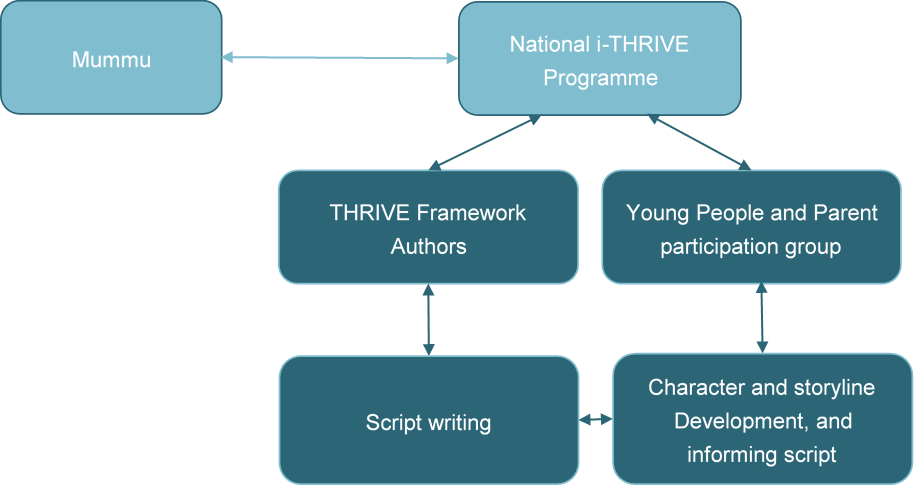
First co-production workshop
Once the draft script had been written, the programme team engaged with the participation leads at the AFNCCF and T&PFT to organise the first in a series of co-production workshops on 23rd January 2020. 3 young people from the Tavistock and Portman Patient and Public involvement team and 5 Young Champions from the AFNCCF attended the workshop which had the following learning objectives:
To gain a basic understanding of the THRIVE Framework and the aims of the animation project
For participants to be able to relate their experiences to the THRIVE Framework needs based groupings
To develop animation scenarios for the content of a video for professionals
The young people were presented with the names and descriptions of the five needs based groupings and asked what they meant to them. A brief overview of the framework was provided and an audio recording of the draft script was played. Large printouts of the different needs based groupings were placed on tables around the room and each group was given 7 minutes at each grouping to draw, write and/or build using plasticine, how they thought each grouping could be visually captured.
The young people involved provided invaluable insights into the different ways that help or support aligned with the framework could be experienced, including from whom and in which contexts or settings, and how each needs based grouping might look.
Image 1. Output from first co-production workshop

Second co-production workshop
Due to COVID-19, the second co-production workshop to review the first draft of the animation was moved from being face to face to remote means on 5th May 2020. This was delivered by zoom, which worked well. All of the children and young people who attended the first workshop were able to attend the second workshop and in addition, one of their parents also attended.
Having viewed the animation we asked the participation group to share their feedback anonymously providing their initial impressions using Mentimeter.
Example feedback from participation group
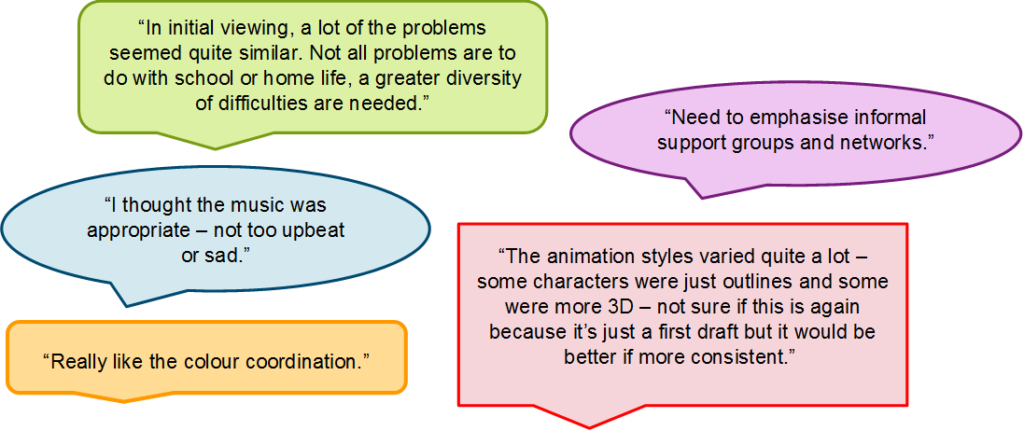
As a group the discussion the focussed on the character development, music, voice over, colours, flow of the story and any improvements that could be made to ensure that the animation explained the THRIVE Framework in a clear and accessible way. A sample of improvements includes:

The programme team synthesised the feedback from the participation group and shared it with the animators to be incorporated in the next phase of the animation development.
Selecting the voice over
A key aspect of co-developing the animation was selecting the voice over. The animators shared a range of voices with the team who shortlisted top three voices. Utilising Survey Monkey we asked the young people and parent participation group to anonymously rank the voices in order of preference and share any additional comments they had about the voices. The survey was open for two weeks in August and intermittent reminder emails were sent. In all, we received seven responses and the top rated voice was shared with the animators to enable them to arrange the recording.
Timeline of the development process
The infographic below outlines the timeline of the development of the animation.
Image 2: Animation development timeline
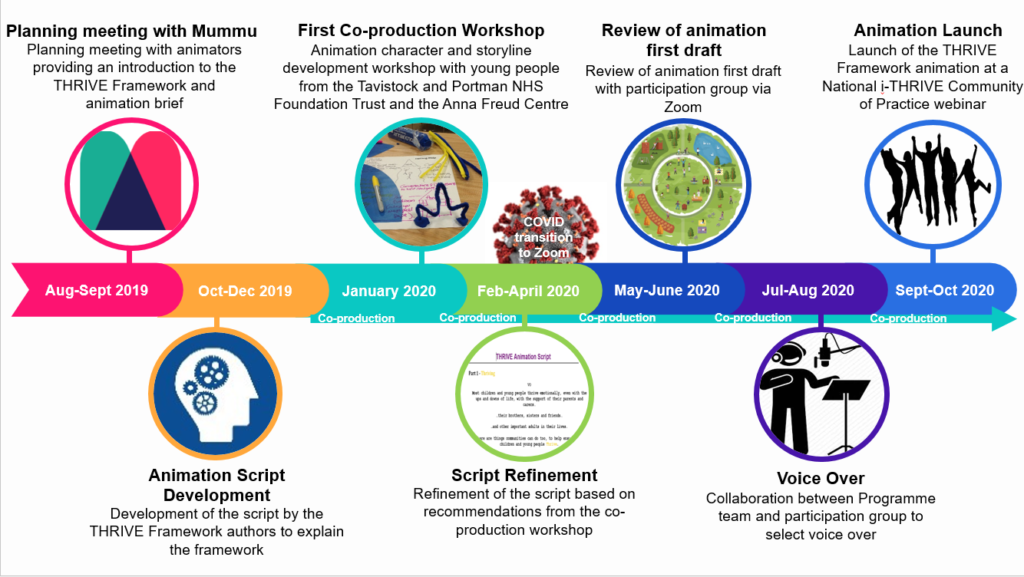
Image 3. Character development

Image 4. Example from the animation storyboard

How we aligned content and process with principles of the THRIVE Framework
Central to the creation of the animation was ensuring that it remained aligned with the THRIVE Framework and its principles at each step of the way.
Common Language
The animation seeks to promote the common language of the framework throughout, referring to the five needs based groupings and consistently using colour throughout the animation to highlight which needs based grouping the children and young people might be accessing support within. For example, a ‘risk support’ depiction within the animation has an orange colour scheme, in line with the colour designated in the THRIVE Framework for system change.
Needs-Led
The concept of a needs based offer, as opposed to one of diagnosis and severity was made explicit, with the young person’s voice and wishes being central throughout. The young people themselves and the experiences they face, according to context (playground, school, sport) and age (use of mobile phone, posters on a wall) were key, and the structure aimed to follow the journeys of a group of children and young people from their point of view.
Shared Decision Making
Shared decision making lies at the core of the THRIVE Framework, and thus was a central principle to highlight within the animation. This was achieved with the idea that although services and professionals were available to support children and young people, it was also up them to access support and make collaborative decisions on what shape they wished their help or support to take. The process of co-production also aimed to uphold this key principal, by utilising the knowledge, experience and feedback of different stakeholders, taking this back to the children, young people and families involved in the co-production to provide updated and edit accordingly; and to model and emphasise the importance of continuous feedback loops.
Proactive Prevention and Promotion
It was important to illustrate the role of ‘Thriving’ as a grouping which children and young people would be supported to move back in to. The animation aimed to highlight helping children, young people, and their whole communities; whether that be a network of family, friends or professionals, or wider community such as faith leaders or youth workers, to build on their strengths together to promote good mental health and wellbeing.
Partnership Working
Throughout the animation, we aimed to ensure a broad range of professionals were depicted, both implicitly and explicitly. For example, there is a section of the animation which shows a child knocking on a series of doors, belonging to ‘Learning Support’, ‘Football Coach’, ‘Faith Leader’ and ‘CAMHS’, emphasising the key concept that there is “no wrong door” when it comes to children and young people seeking help or support for their mental health and wellbeing and that service providers work collaboratively to ensure that these needs are addressed. Moreover, this further promoted the importance of different types of help and support offered not solely reflecting those working within specialist mental health services and was inclusive of everyone a child or young person might seek support from in their life, including friends, family and professionals from across their landscape.
Image 3: An example of the range of professionals depicted within the animation

Outcome Informed
There was direct reference to the help and support being offered coming from a strong evidence base, as this is what has been shown as most likely to effectively support children, young people and their families. Although there was not scope to go into the limits of interventions, or the whole range of treatment options available, the animation strived to convey the importance of considering a full range of options, including self and community approaches.
Reducing Stigma
The animation strived to promote mental health and wellbeing difficulties being addressed in a manner that reduces stigma, by ensuring that mental health and wellbeing is everyone’s business, and also by promoting the key concept that the majority of children and young people do experience the normal ups and downs of life but may benefit from prevention and promotion strategies in order to promote ‘Thriving’. By acknowledging throughout the animation that these difficulties are normal and emphasising that support networks are available and willing to offer help and support as a core part of their role, this aims to destigmatise normalise help seeking behaviour.
Accessibility
The core principle of accessibility was key throughout the animation; not only in terms of promoting help and support being available in ways that suite the child or young person, i.e. in a timely way and in a place they would ordinarily go; but also that the animation depicted a range of diverse and inclusive characters and story arcs throughout. Efforts were made to represent the core protected characteristics as outlined in the Equality Act: age, disability, gender/gender reassignment, race, religion/belief, and sexual orientation, and marriage, pregnancy and maternity. Moreover, although the animation itself is not explicitly accessible to those who are visually impaired or those who speak other languages, the narration is detailed enough so that it can be followed without necessarily watching the animation, and a transcript is also provided. The National i-THRIVE Programme Team are also exploring options for the transcript to be translated into other languages.
How does this fit into National i-THRIVE Programme strategic developments?
The animation acts as a tool to increase the dissemination of the THRIVE Framework, allowing localities across the country an opportunity to grasp the key concepts of the framework in a concise, clear and easily digestible manner. This, along with the other resources available on the National i-THRIVE Programme website, such as the implementation stories, 7 minute briefings, slide decks and Q&As, could enable sites to consider approaching the National team to discuss implementation of the framework within their locality and begin to work towards a more integrated model of care through accessing stakeholder engagement events, i-THRIVE Academy modules, or i-THRIVE Academy e-learning.
The animation serves a dual purpose of increasing the awareness and understanding of the framework across the children’s workforce, and also as a tool to use with children, young people and families to explain the needs based grouping, key concepts such as shared decision making and ‘no wrong door’ and also to promote interagency working by illustrating the connected manner in which different settings, professionals and trusted adults can work together across all levels of a service.
How has this approach affected service users?
The service users who worked alongside the Programme provided valuable feedback on their experiences of co-production, and why service user involvement felt important to them. In a survey, all respondents rated their experience of participating in the creation of the animation as ‘Good’ and stated that they thought it was important to include participation groups when developing resources about children, young people and their families. The overwhelmingly positive experience of the Programme in conducting this piece of work with service users has confirmed the importance of service user involvement in any publications or resources which are either developed for or about working with children, young people and their families, to ensure their voice is heard.

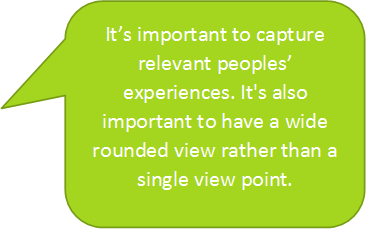
What were the Animators’ experiences of co-production with the NHS?
Although Mummu have collaborated with the NHS previously, the method wholly co-producing with multiple stakeholders and incorporating service user involvement was a new experience. In a recent feedback survey, Mummu stated that they did think it is important to include participation groups when developing resources about children, young people and their families. They shared that the experiencing of co-producing the animation with the NHS did differ from other experiences of working on commercial projects, due to differing priorities regarding script, characters and content and the implications this can have on the studio in terms of schedule and budget.
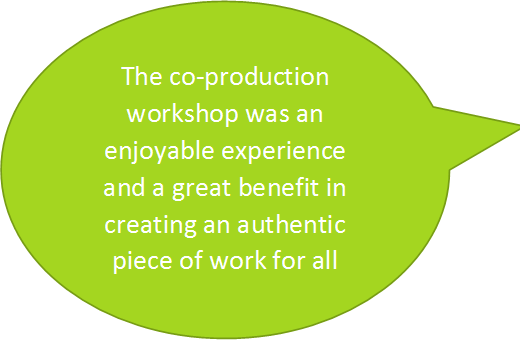
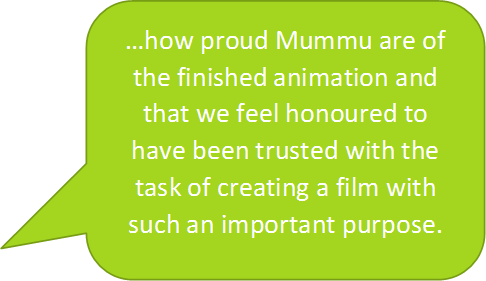
Watch the animation by clicking on the image below:
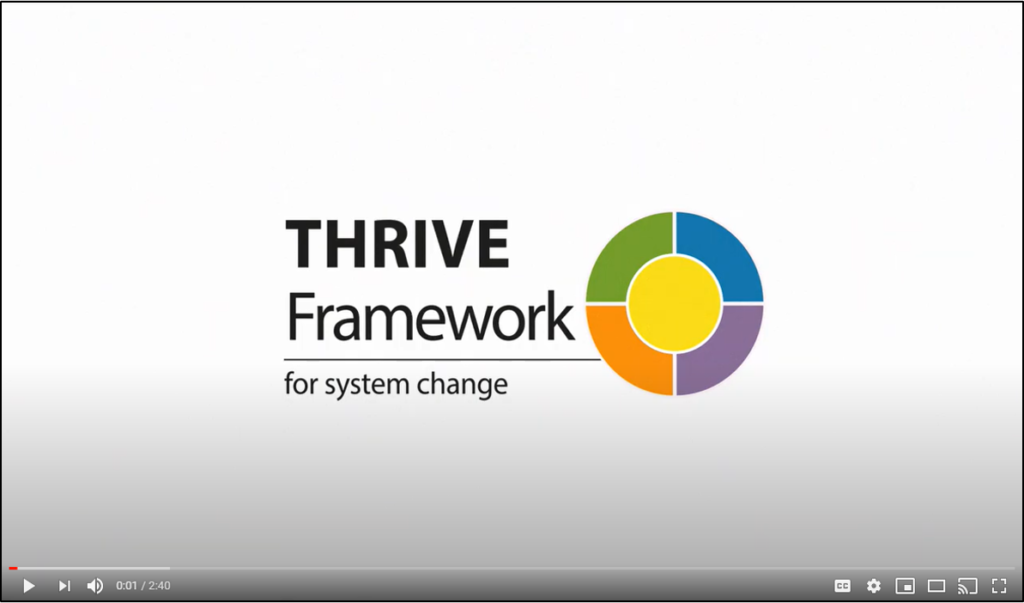
Acknowledgements
Special thanks to Young Champions, Rufus Carroll, Tomaz, Lie Walters and Gail Walters, Mummu, the THRIVE Framework author group and University College London.
If you would like further information, please contact the National i-THRIVE Programme Team at ithriveinfo@tavi-port.nhs.uk.
Edited by the National i-THRIVE Programme Team.
Written October 2020.